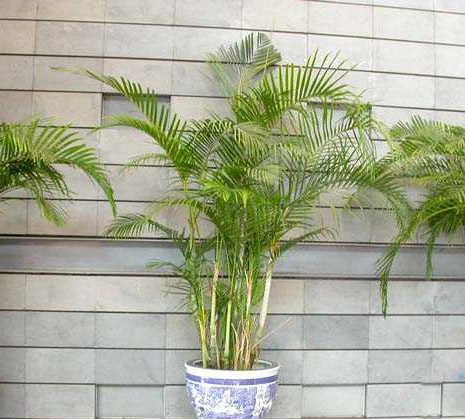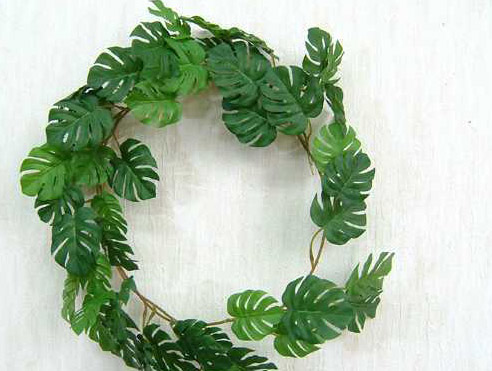What should be paid attention to in potted pocket coconut
Pocket coconut, famous sleeve, rare brown and so on. It is a small evergreen dwarf shrub of Palm family. Plant shape short; stem solitary, erect unbranched, dark green, with irregular ring pattern above; leaf pinnatifid, divided into lanceolate, dark green, leathery, glossy; flowers yellow, globular, blooming in late spring and early summer. The fruit is ripe and orange-red after autumn.
Sex likes high temperature, humid and semi-overcast environment, and is not resistant to drought and cold. Because the root system of pocket coconut is slender, it is appropriate to choose loose and fertile soil when potted. Because it prefers shady environment, indoor cultivation should be placed near the north window, east window or other places with bright scattered light. Pocket coconut is most afraid of strong light, even if it is exposed to the sun for a short time, it will cause the leaves to scorch and turn yellow. If placed in a dark place for a long time, the leaf color will also become lighter and the glossiness will be weakened. The suitable temperature for growth is 20-30 degrees Celsius, the winter room temperature should be 12-14 degrees Celsius, and the lowest temperature should not be less than 10 degrees Celsius.
Pocket coconut has strong water absorption, it is necessary to keep the basin soil moist during the growth period, and control watering during the dormant period. Summer watering should be adequate, and often spray water on the leaf surface to increase air humidity. In order to meet the needs of indoor viewing, the plant height should be controlled at 40-60 cm, so fertilization should not be too much. In the seedling stage, the dilute liquid fertilizer should be applied for 3 times in spring and autumn. The best fertilizer type is 1.5: 1.2 of nitrogen and phosphorus. This ratio can not only make the stem strong, but also improve the leaf glossiness. Change the second basin every 2-3 years in spring to facilitate growth. Because the cuttage of pocket coconut is not easy to survive, it is mainly propagated by sowing method.

On the contrary, if placed in a dark place for a long time, the leaf color will become lighter and the glossiness will be weakened. The suitable temperature for growth is 20 ℃ ~ 30 ℃, the room temperature in winter is 12 ℃ ~ 14 ℃, and the lowest is not less than 10 ℃. Pocket coconut has strong water absorption, it is necessary to keep the basin soil moist during the growth period, and watering should be controlled during the dormant period. Summer watering should be adequate, and often spray water on the leaf surface to increase air humidity. In order to meet the needs of indoor viewing, the plant height had better be controlled between 40 cm and 60 cm, so fertilization should not be too much. In general, in the seedling stage, the dilute liquid fertilizer should be applied 4 times in spring and autumn. The best ratio of nitrogen to phosphorus in fertilizer is 1.5 to 1.2. This ratio can not only make the stem strong, but also improve the leaf glossiness. Change the basin every 2-3 years in spring to facilitate growth. Because the cuttage of pocket coconut is not easy to survive, it is mainly cultivated by sowing method. Small potted pocket coconuts cultivate small potted pocket coconuts. When I heard the name, I thought it was a reduced version of coconut trees. As a result, I saw small potted pocket coconuts in the flower-and-bird market, which was slightly different from what I had imagined. However, the shape of the small-sleeved potted coconut is still very similar to that of the tropical coconut tree, with its petite and exquisite body, which is why it is named pocket coconut. Among the many plants, the author chose the shade-tolerant small pot pocket coconut as the indoor plant, so that the indoor is full of tropical atmosphere, similar to this kind of small potted plant is very popular today. Small potted pocket coconut-evergreen dwarf shrub, belonging to the palm family. The planting height is about 1m, the stem of the small potted pocket coconut is thin and long, the leaf grain is irregular, longer than the top of the branch, the green is dark, the leaflet branch is split, the lobe is the widest below the middle, the upper part is attenuated, and the shape is like a sickle with luster. Small potted pocket coconuts bloom in spring, with small yellow globular flowers, divided into male and female flowers, the male flowers are neatly arranged and erect, while the more nutritious male flowers are slightly bent due to luxuriant flowers, and the ripe round berries are orange-yellow. Pot substrate: small pot pocket coconut roots are slender, so it is necessary to use good drainage, wet, fertile culture soil as the cultivation substrate, if the clay heavy soil will appear the phenomenon of rotten roots. Lighting: small potted pocket coconuts like shade. If placed indoors for cultivation, they can be placed in a shady environment or in a place with faint astigmatism. Small pot pocket coconut is most taboo by the direct exposure of strong light, only a moment of exposure, will also lead to dry leaves withered and yellow, the loss of the original color. On the contrary, if the small potted pocket coconut is placed in an excessively dark position for a long time, the color of the leaves will also become lighter and lose the original gloss. Small potted pocket coconuts are cultivated outside the room to cover the shade net and block about 60% of the light. Temperature: small pot pocket coconut in high temperature, high humidity and semi-overcast environment, it grows faster, small pot pocket coconut is the most taboo is the direct beam of light. During the growing period, the temperature of 20 ℃ ~ 30 ℃ is the most suitable, and the indoor temperature of 12 ℃ ~ I4 ℃ in winter is suitable, and the lowest temperature should not be below 10 ℃. 13 ℃ will enter the dormant state, the indoor temperature of about 8 ℃ can safely survive the cold winter. Moisture: small pot pocket coconut has strong water absorption, can often add water during the growth period, so that the basin soil is in a moist state, the amount of water in the dormant period has to be controlled. Small potted pocket coconuts are well watered in summer, and often spray some water on the leaves to increase the humidity of the air, and there can be stagnant water in the basin. The relative dormancy period of small potted pocket coconut is from October to February of the second year (the night temperature is 12 ℃ ~ 14 ℃). To reduce watering as long as make the pot soil moist, prevent the temperature is too low so as to cause root rot, leaf yellowing and necrosis. If you put small potted pocket coconuts in an air-conditioned room with heating, you should keep the potted soil moist and often spray water on the leaves to increase the humidity of the leaves. Small potted pocket coconut is propagated by sowing method or plant division method. Sowing method: the small potted pocket coconut plant with good growth and strong growth can blossom for 3-4 years, and the seeds can be obtained by artificial pollination. It takes 6-7 months for its fruit to mature. The small pot pocket coconut seeds just picked can be sown. Before sowing, the small pot pocket coconut seeds should be soaked in warm water of 35 ℃ ~ 40 ℃ for 36 hours. After the small pot pocket coconut seeds absorb water and expand, they will be filled with soil at 1.5cm, watered with tiny sprinklers at the orifice, covered with plastic film above the pot mouth, and the temperature should be increased to control the temperature range from 22 ℃ to 25 ℃. Small potted pocket coconut seeds will germinate within 30-40 days. Until 2 or 3 true leaves emerge from the seedlings, the pots can be filled with soil lumps. Ramet propagation: small potted pocket coconut has more tillers from emergence to jointing period, so it should be divided. It is best before the end of winter and the resumption of growth in early spring.
- Prev

How to cultivate potted sunflower
Loose-tailed sunflower is evergreen shrub or small Arbor of Palm family. Tufted, often branched from the ground; pinnately compound leaves cleft, expanding and slightly curved, lobes 40-60 pairs, arranged in two rows, smooth and bright green. Leaflets linear or lanceolate, about 30 cm long and 1 cm wide
- Next

How to cultivate mini-tortoise-backed bamboo
Potted mini tortoise back bamboo is relatively simple, the growing season on the indoor bright scattered light, winter near the south windowsill, so that it sees more sunshine, the growth is more robust. The suitable temperature for growth is 20-30 degrees Celsius, and the air temperature should be kept at 60%-80%. The overwintering room temperature should be kept above 12 degrees Celsius.
Related
- Fuxing push coffee new agricultural production and marketing class: lack of small-scale processing plants
- Jujube rice field leisure farm deep ploughing Yilan for five years to create a space for organic food and play
- Nongyu Farm-A trial of organic papaya for brave women with advanced technology
- Four points for attention in the prevention and control of diseases and insect pests of edible fungi
- How to add nutrient solution to Edible Fungi
- Is there any good way to control edible fungus mites?
- Open Inoculation Technology of Edible Fungi
- Is there any clever way to use fertilizer for edible fungus in winter?
- What agents are used to kill the pathogens of edible fungi in the mushroom shed?
- Rapid drying of Edible Fungi

